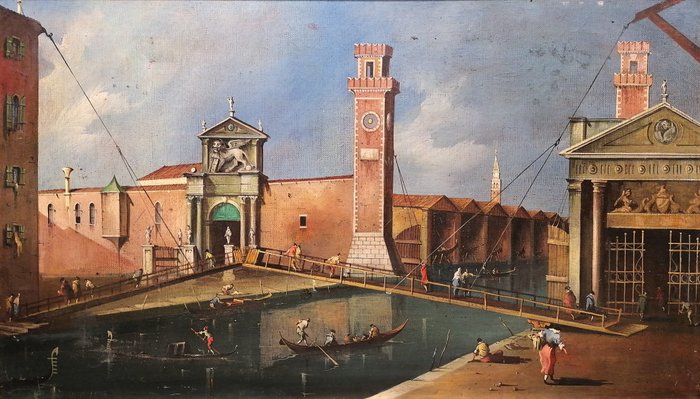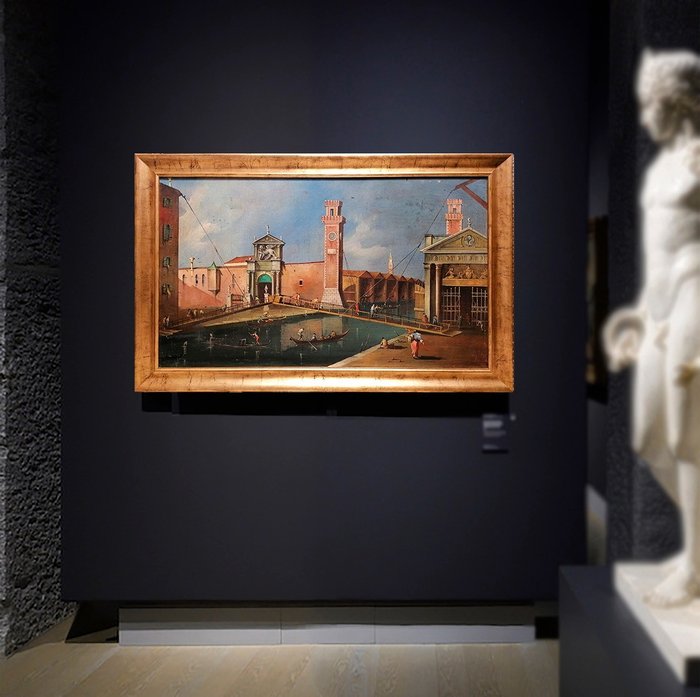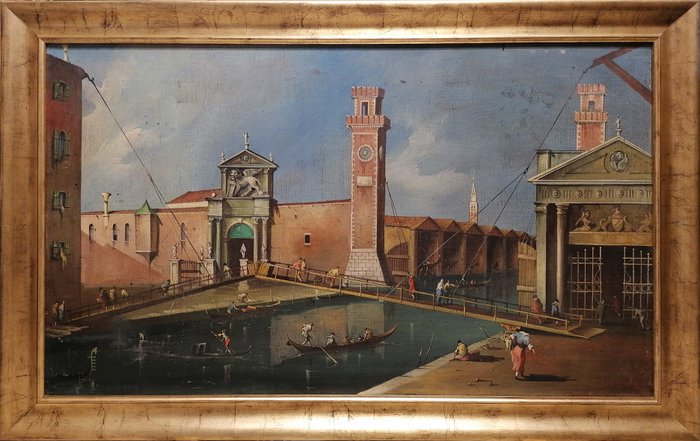Advert Description
Are you interested in this item? This item is up for auction at Catawiki. Please click on "respond to advert" (orange button) to get redirected to the Catawiki website. Catawiki’s goal is to make special objects universally available. Our weekly auctions feature thousands of unusual, rare, and exceptional objects you won’t find in just any store. VENETO PAINTER OF THE XIX / XX CENTURY
Follower of FRANCESCO GUARDI (Venice, 1712 - 1793)
The entrance to the Venice Arsenal
Oil on canvas, cm. 70 x 120 - Not signed
Size with frame, cm. 85 x 135 x 6 approx.
NOTES: Publication of the catalog of works from the Intermidiart collection. Unsigned work. Certificate of Guarantee and Lawful Origin. Artwork with golden frame:
Magnificent view of the Venice lagoon with the entrance to the Venice Arsenal. The work, attributable to an artist active in the nineteenth / twentieth century and clearly influenced by the stylistic and compositional examples of Francesco Guardi, appears beautifully executed and of good quality and is a very interesting testimony of ancient Venice portrayed from one of the most famous views of the city. In the 19th and 20th centuries, some anonymous painters tried their hand at the art of "copying" the great masters of the past. One of these was Canaletto, followed by his nephew Bernardo & Francesco Bellotto, Michele Marieschi and Francesco Guardi, even if his photographic painting - by the master Canaletto - remains inimitable. The painter who performed this work obviously did not want to refer to the master's technique, but he managed with talent to paint this famous view of Venice making us rediscover it in one of the beautiful dawns on the Lagoon. The splendid panoramic view of the canal, taken from a point of view located at the entrance to the Venice Arsenal, was a subject made by Antonio Canal known as Canaletto (Venice 1697 - 1768), only to be later taken up by other talented successors - including which Francesco Guardi - until today.
This image refers to the original - with variants - The entrance to the Venice Arsenal (oil on canvas, 1777-1793, Kunsthistorisches Museum, Vienna, Austria), however, is a model already taken up by Canaletto. The boats and the characters sometimes change, and so does the point of view captured with the optical camera. However, the result is always extraordinary and perfect.
Returning to our painting, let's focus on the details. The space is marked by the sky, the waters and the wonder of Venice, fixed as in a high-definition image in which no detail escapes us. The green of the lagoon reflected on the sky, the boats near and far, the chatter of the people on the shore and on the gondolas. The view of the lagoon, with the gondolas on the calm water of the canal, with the rich figures: on the shore of the pier, on the gondolas and on the bridge at the entrance to the Arsenale. The scene is represented with particular attention by the facade of the Venetian Arsenal building, which harmoniously follows the lagoon on the sides. In the blue-green firmament, the luminous clouds move in parallel lines diagonally from top left to right. The people acting in the gondolas, boats, shore and bridge are vividly reproduced, in part, in narrative poses. The eighteenth-century garments of the people are all pastel or gray-brown: Venice does not participate in the cheerful polychromy of the clothes of Paris and London. Even the gondolas are for the most part strictly all black. The long shadows and the sun that illuminates the shore make us understand that the scene stares at the city in a lively and laborious day of turmoil. The light - probably in the afternoon - enhances the architectural details of the seventeenth-eighteenth-century palaces and of the bridge. The canvas is a snapshot of life and everyday life that makes us understand how little Venice has changed in over three hundred years, from an architectural point of view. But there is more: in this as in many other works by the great masters of the eighteenth century, we have the sensation of the temperature of the air, of its degree of humidity, of the light breeze that moves this air. All sensations that no modern photography can give us. Anyone who looks at a photograph knows that it is a photograph, but whoever looks at a work by Canaletto and his followers, like this one and lingers carefully, will have the sensation of perceiving reality concretely. The secret lies in painting with a free, simplified stroke that will then be reworked by the mind of the observer, generating an impression of truth. The same approach that Claude Monet will use over a century after he shared with Canaletto the sense of light and the simplicity of the sign that represents it. It is therefore the brain that recomposes the image, because as we well know we do not see with the eyes but with the mind. And all this gives us a truer image than the photo shoot.
The painting considered here is characterized by a perspective approach almost identical to that of the museum versions. The similarities extend to the boats, the figures and the general chromatic affinity, despite the different dimensions. The view, characterized by a good executive level, is attributable to a valid follower of Francesco Guardi - active between the end of the nineteenth century and the beginning of the twentieth century - who was able to render with great skill the characteristics of the style and atmosphere of the preserved views. in museums. The well-known Venetian artist, in fact, can be traced back to the illustrative invention, the free and vibrant rendering of the speckles, the loose chromatic application even in the creation of the wide skies furrowed by clouds: all aspects that recall precise guardesque styles.
Regarding its state of conservation, the canvas is in fairly fair general condition considering the age of the painting, the painted surface is in patina. We can see - in Wood's light - some small scattered restorations and some slight unveiling and oxidation of the pictorial surface, however nothing really relevant. There are no conservative problems and it does not seem to need urgent interventions. In sunlight, a fine crackle is visible compared to the time. The measures of the canvas are cm. 70 x 120. The beauty of the canvas is highlighted by a gilded frame that blends perfectly into an impressive ensemble (the dimensions of the frame are approx. 85 x 135 x 6 cm, presence of defects). "The frame shown in the photos above was added to the artwork by the seller or a third party. The frame is provided to you at no additional cost so that it is ready to display as soon as it arrives. The frame is included by way of title. courtesy and is not considered an integral part of the artwork. Therefore, any potential damage to the frame that does not affect the artwork itself will not be accepted as a valid reason to open a claim or request cancellation of the order . "
Provenance: Coll. private
Publication:
? Unreleased;
? The Myths and the Territory in Sicily with a thousand cultures. UNEDITED QUADRERIA general catalog of paintings from the collection of the cycle "Myths and the territory", Editore Lab_04, Marsala, 2023.
We also guarantee accurate packaging with external wooden crate and bubble wrap / cardboard / internal polystyrene (packaging cost approximately € 130.00) and tracked shipping (€ 120.00 Italy). For export, the work is subject to a request for a Certificate of Free Movement (European Community) or Export Certificate (Extra-Community Transport), at the export office (Superintendency of the territory) with the times and costs incurred ( € 500 / € 1,000, all included: shipping, packaging and particular exports).
The shipment could be delayed by a few days/weeks for logistical and administrative reasons. 67519941





